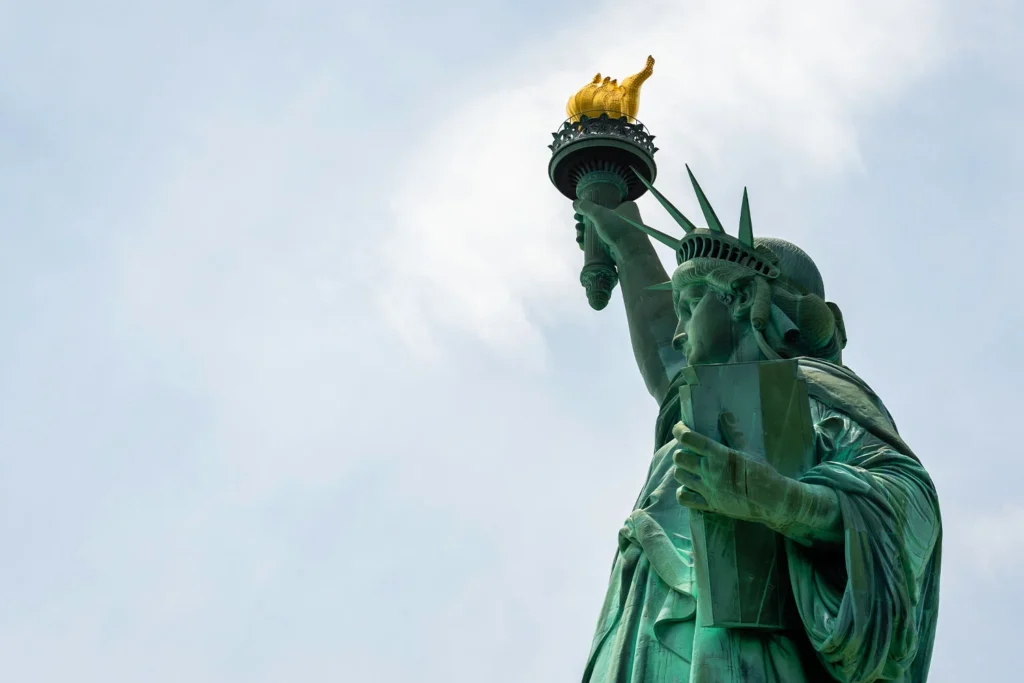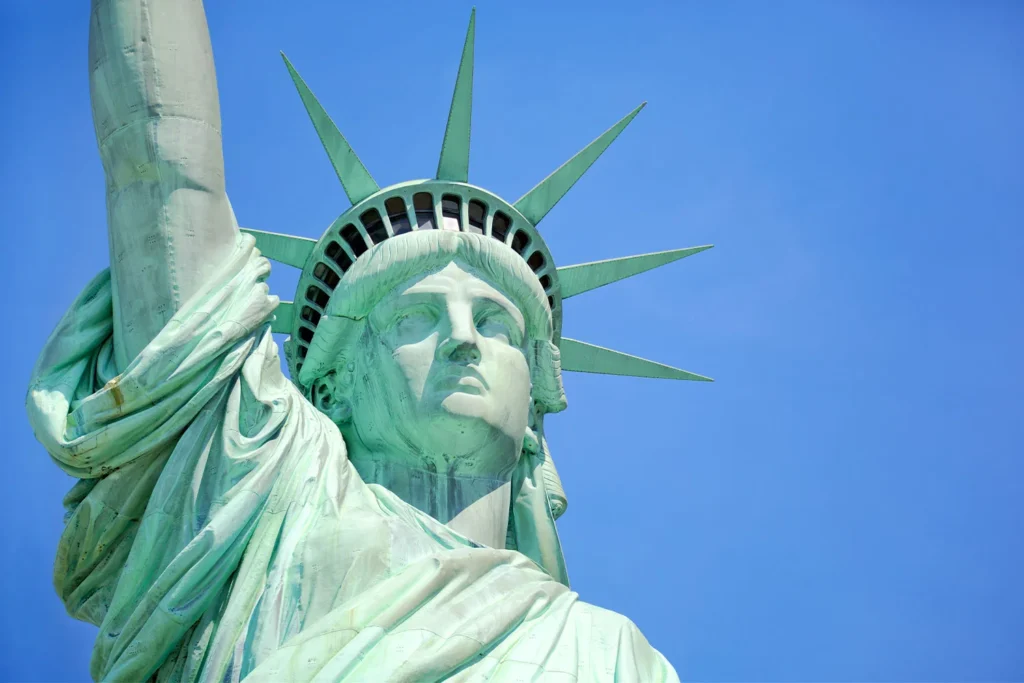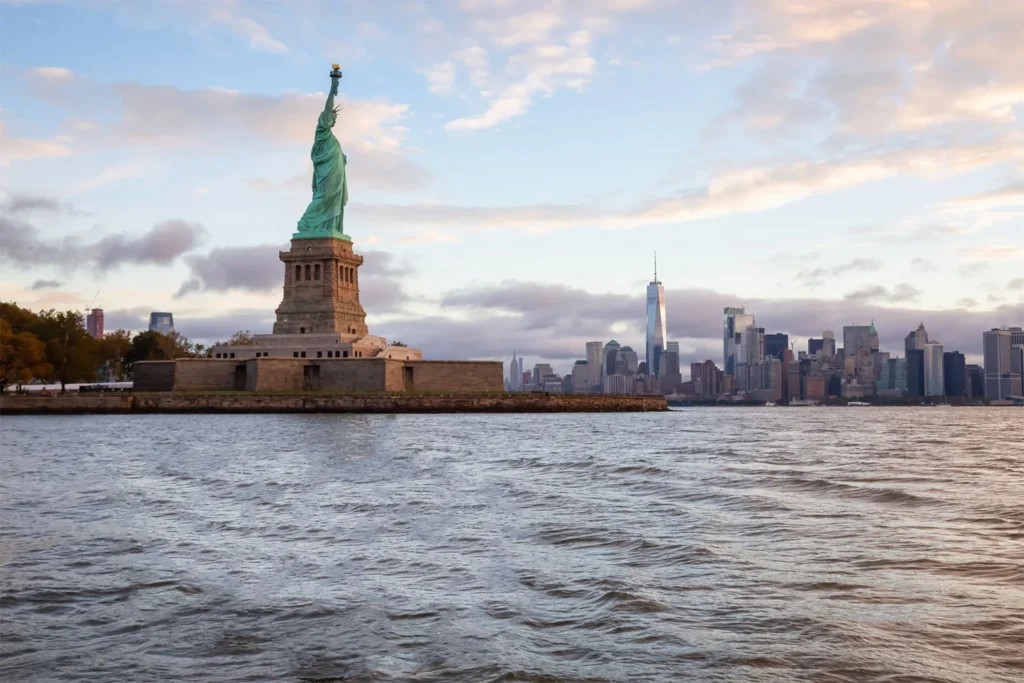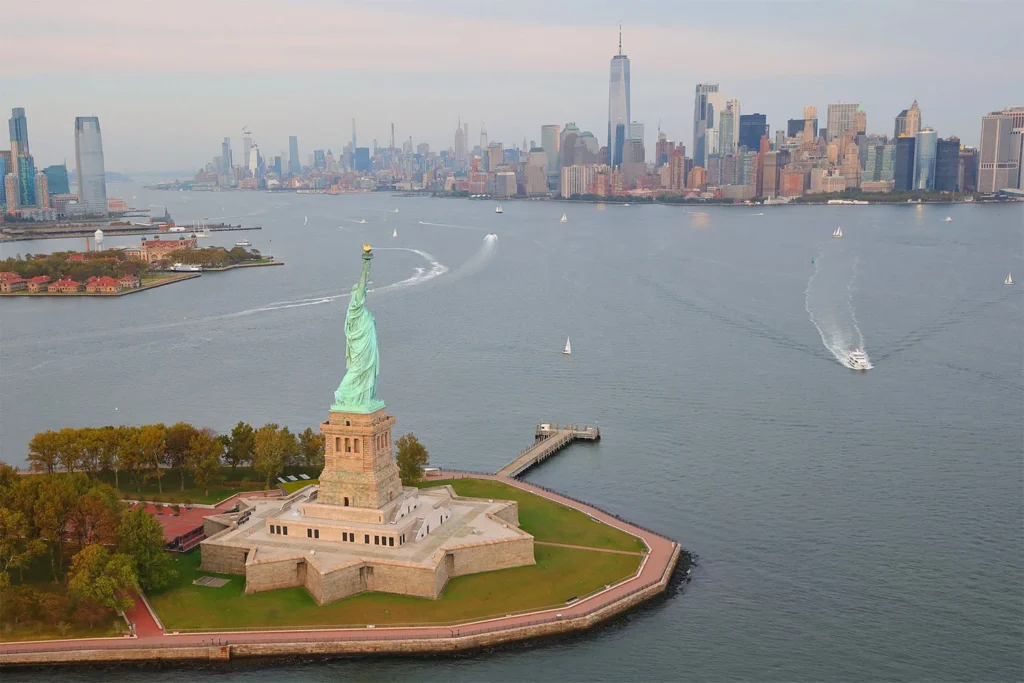That monument is a symbol of the United States, New York, freedom, and the pursuit of dreams. Its iconic form is recognized in every corner of the world, yet it still holds many little-known stories. It’s time to shed some light on them.
The Statue of Liberty, alongside the Empire State Building and the Brooklyn Bridge, is one of the most important symbols of New York. For over a century, this monument has inspired dreamers and immigrants worldwide. Everyone has heard of it, but not everyone knows that its official, original name is Liberty Enlightening the World. Today, it’s often referred to by New Yorkers as Lady Liberty or sometimes even Mother of Exiles. It’s to this resident of a small island on the Hudson River, on the western edge of New York, that we pay an unannounced visit today.
The Most Famous Gift in the World
The statue, now a symbol of the entire country, was a gift from France to the United States. However, it wasn’t exactly a surprise present—the Statue of Liberty was meant to be a collaborative creation between the two nations, commemorating the alliance formed during the American Revolutionary War.
The person behind Lady Liberty was Frédéric Auguste Bartholdi, a French sculptor. However, he didn’t work alone. Bartholdi needed someone to handle the structural engineering aspects of the design for the large-scale statue.
Gustave Eiffel, the famous engineer behind the Parisian tower that bears his name, joined the project to help with the Statue of Liberty’s structural design. But what role did the United States play in this endeavor? Along with raising funds, the American side was responsible for constructing a special pedestal on which the statue would be placed.
FUN FACT: An American poet, Emma Lazarus, contributed to fundraising efforts by writing a poem specifically for this occasion, titled “The New Colossus.” You can read her poem during your visit to New York, as it was engraved on a bronze plaque and placed at the base of the Statue of Liberty in 1903.
How Did the Statue of Liberty Reach the United States?
The creative process was completed in 1884. The statue was officially handed over to the U.S. ambassador in Paris and then shipped to America. If you’re imagining the statue majestically sailing across the Atlantic Ocean, greeting onlookers from the shore, I might disappoint you. The completed statue was actually disassembled into 350 parts in France and packed into 214 crates. The ship carrying this precious cargo arrived in New York Harbor on June 17, 1885, but the statue had to wait another year for the pedestal to be finished.

The Statue of Liberty was officially dedicated on October 28, 1886. However, this was not the originally planned date. The monument was intended to commemorate the centennial of the signing of the U.S. Declaration of Independence in 1776, but it ended up being delayed by about… 10 years. Both the statue and Liberty Island are federal properties managed by the National Park Service. Since 1924, the Statue of Liberty has been recognized as a national monument of the United States, and in 1984, it was added to the UNESCO World Heritage List.
Statue of Liberty Up Close
It’s hard to find anyone unfamiliar with the iconic image of the American lady standing tall on her pedestal. After all, it’s arguably the most famous statue in the world. However, not many people consider the finer details of its appearance before visiting New York City. The statue’s structure is made of steel and copper. But where is the copper color? Long gone, it has since been covered by the green patina formed through natural weathering of the copper.
The statue is an example of realist neoclassicism, a style inspired by ancient art. It depicts a woman holding a flaming torch in her right hand and a tablet in her left, on which the date of American Independence Day is inscribed. Some people believe that the concept for the Statue of Liberty was influenced by Eugène Delacroix’s painting, Liberty Leading the People. Such theories are hard to dismiss, given the undeniable similarities between the two figures.

The woman immortalized in the form of the Statue of Liberty does not represent any specific person. Instead, the statue was meant to embody values and ideals. However, there are various hypotheses regarding the figures that Frédéric Auguste Bartholdi used as models. Some historians suggest that the sculptor was inspired by the ancient Roman goddess Libertas, who symbolized freedom and liberty. Others believe that Bartholdi gave Lady Liberty the facial features of his mother, while her body was modeled after the figure of his lover.
FUN FACT: The statue gifted to the U.S. by France stands over 46 meters tall and weighs 225 tons. It’s almost hard to imagine, but Lady Liberty’s finger alone is nearly 2.5 meters long. The pedestal, on the other hand, is 47 meters high, making the top of the statue reach a height of nearly 100 meters.
Symbolism of the Statue of Liberty
Lady Liberty, guarding American freedom, is surrounded by a wealth of symbolic elements. The most important is, of course, the torch held high above her head, representing enlightenment and a bright future. The broken chains at her feet symbolize liberation, while the seven rays on her crown represent the seven continents, emphasizing the universal nature of freedom.
The toga worn by Lady Liberty also holds significant meaning. It is a nod to the classical Greco-Roman tradition, which forms the foundation of modern democracy. Another connection to ancient culture is the statue’s Morton’s toe syndrome (a condition where the second toe is longer than the big toe), which the Greeks associated with noble lineage. Beyond the symbolism in specific elements of the statue’s appearance, the figure as a whole represents for many the famed American Dream, a vision of a better future and the freedom embodied by the United States.
The Old and New Torch
According to Bartholdi’s original vision, the flame of the Statue of Liberty’s torch was not supposed to be illuminated, but instead, crafted from gilded copper to reflect daylight. This concept was, however, altered several times. Shortly after the statue’s unveiling, holes were cut into the metal, and it was lit from within. Six years later, a skylight made from red, white, and yellow glass was installed at the top of the flame, and in the early 20th century, the copper was replaced with amber glass, followed by yet another lighting system.
During the statue’s restoration in the 1980s, it became evident that the original torch was too damaged to be preserved. It was replaced with a replica that restored Bartholdi’s initial concept. The original torch can still be viewed in the Statue of Liberty Museum. In the past, visitors could climb up to the torch. However, after a 1916 explosion caused by German saboteurs, which damaged the statue’s arm and resulted in the deaths of seven people, the torch’s interior has been closed to the public ever since.

FUN FACT: During the time when the Statue of Liberty’s torch was still lit, a Morse code signal was transmitted from it in 1944. This happened on the day American forces landed on the beaches of Normandy at the start of Operation Overlord during World War II. The code sent was “dot, dot, dot, dash,” the Morse equivalent of the letter “V,” which stands for “Victory”.
Statue of Liberty Museum
With the opening of the Statue of Liberty Museum in 2019, visitors were given a new opportunity to explore the iconic monument in greater depth. The museum is divided into three distinct galleries, each offering an interactive experience that presents the story of Lady Liberty in an inspiring and thought-provoking way.
In the Immersive Theater section, visitors can enjoy a unique experience where interactive images surround them, telling not only the story of the Statue’s creation but also offering a virtual journey inside the monument. The next gallery, through multimedia displays, showcases the complex process of designing, constructing, and assembling the Statue of Liberty. The final gallery allows visitors to get an up-close view of the original torch, which was once part of the iconic statue.
The glass walls surrounding the final gallery allow visitors to combine their exhibition experience with panoramic views of Lady Liberty and New York City. However, don’t linger by the windows for too long because even better vistas await at the top of the museum. The open-air rooftop terrace is the perfect spot to take in the stunning views of the New York skyline, the harbor, and the iconic statue guarding the city. The terrace also offers a fantastic opportunity for artistic shots of the Statue of Liberty, framed against the flagpole plaza.
How to Visit the Statue of Liberty?
The Statue of Liberty welcomes close to a thousand visitors daily. How can you become one of them? Let me explain. Every ticket for visiting the statue includes a ferry ride departing from the Battery Park port. There are several options for visiting Liberty Island. The basic ticket provides ferry access, an audio guide, entry to the Statue of Liberty Museum, and the Ellis Island National Museum of Immigration, located on the nearby Ellis Island.
Other ticket options grant access to the observation points within the statue itself. The lower one is the pedestal, located at roughly the height of a 10-story building. If you’re feeling more adventurous, you can ascend to the statue’s crown. Keep in mind, though, that while an elevator can take you to the top of the pedestal, the only way to reach the crown observatory is by climbing 162 narrow spiral steps. This attraction is not suitable for visitors with mobility issues.

It’s best to buy tickets in advance online, especially if you’re interested in accessing the pedestal or the Statue of Liberty’s crown. The number of these tickets sold each day is limited for safety reasons, so if you’re eager for a closer encounter with Lady Liberty, it’s wise to secure your spot early.
GOOD TO KNOW: To better plan your trip, keep in mind that before boarding the ferry, you’ll need to go through a security screening similar to those at airports. It’s best not to line up at the last minute but to arrive at the port at least 15 minutes before the departure time printed on your ticket. Also, be prepared for unreliable cell service on Liberty Island, so download your e-tickets beforehand, and if you’re meeting other group members on the island, agree on a specific meeting point ahead of time.
The National Museum of Immigration
You might be wondering why tickets to Liberty Island also allow a stop at nearby Ellis Island and entry to the National Museum of Immigration. Well, the Statue of Liberty symbolizes a brighter future for immigrants, and Ellis Island, New York’s first immigration station, shares deep historical ties with this symbol. At the museum, you’ll see the historic baggage room, interview room, dormitories, and the reception areas where immigrants underwent medical and legal examinations. But that’s not all—the museum hosts numerous exhibits that dive deep into the history and complexity of immigration to the United States.
Where to View Lady Liberty?

Not everyone will have the chance to visit Liberty Island while touring New York City, but that doesn’t mean you should miss the iconic view of Lady Liberty. You can capture her in photos from The Battery park, where the ferries depart, but that’s not the only great spot for viewing. You’ll also get a clear sight of her from the One World Observatory, the Brooklyn Heights Promenade, or Governors Island. For a truly unique experience, take a stroll across the Brooklyn Bridge. During your walk, you’ll not only see the city’s most famous monument, but you’ll also enjoy a captivating view of Lower Manhattan’s skyline.
Practical information
- It is best to purchase tickets for the Statue of Liberty in advance. This way, you can avoid standing in long lines and reduce the risk of tickets being sold out.
- Address: Liberty Island, New York, NY
- Buy tickets on GetYourGuide